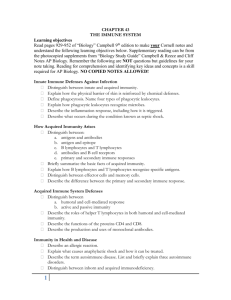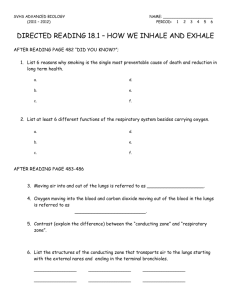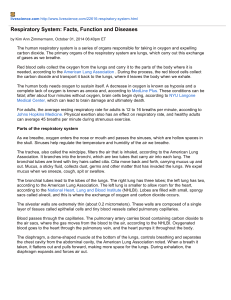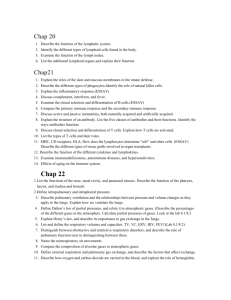Lecture Outline - Anatomy and Physiology
advertisement
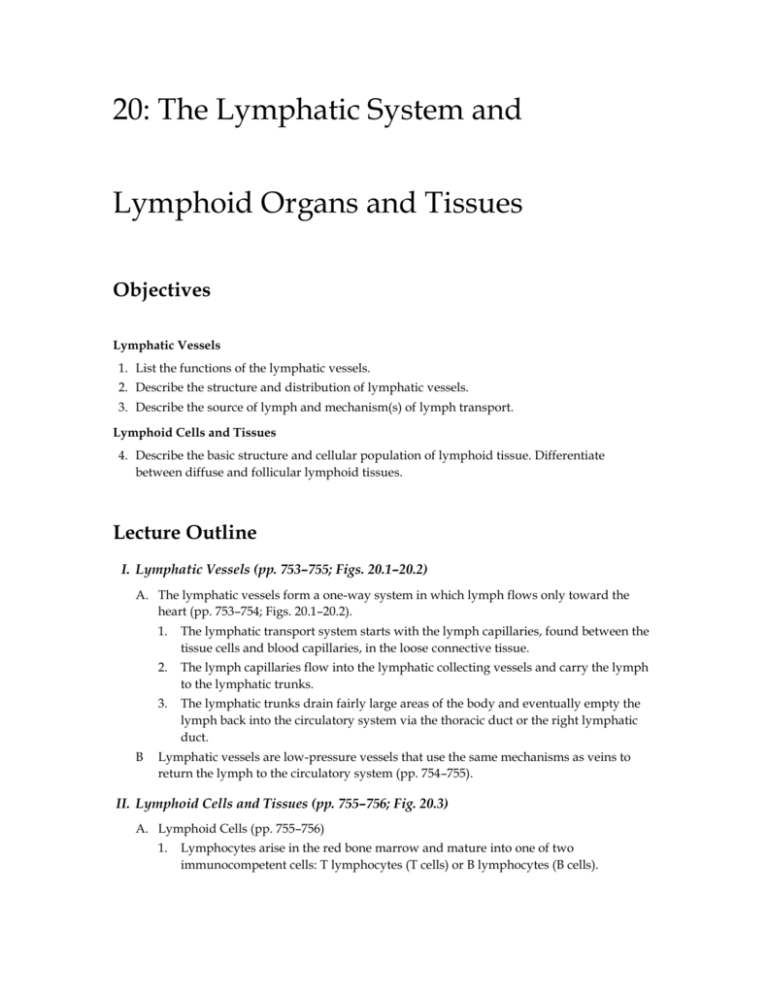
20: The Lymphatic System and Lymphoid Organs and Tissues Objectives Lymphatic Vessels 1. List the functions of the lymphatic vessels. 2. Describe the structure and distribution of lymphatic vessels. 3. Describe the source of lymph and mechanism(s) of lymph transport. Lymphoid Cells and Tissues 4. Describe the basic structure and cellular population of lymphoid tissue. Differentiate between diffuse and follicular lymphoid tissues. Lecture Outline I. Lymphatic Vessels (pp. 753–755; Figs. 20.1–20.2) A. The lymphatic vessels form a one-way system in which lymph flows only toward the heart (pp. 753–754; Figs. 20.1–20.2). B 1. The lymphatic transport system starts with the lymph capillaries, found between the tissue cells and blood capillaries, in the loose connective tissue. 2. The lymph capillaries flow into the lymphatic collecting vessels and carry the lymph to the lymphatic trunks. 3. The lymphatic trunks drain fairly large areas of the body and eventually empty the lymph back into the circulatory system via the thoracic duct or the right lymphatic duct. Lymphatic vessels are low-pressure vessels that use the same mechanisms as veins to return the lymph to the circulatory system (pp. 754–755). II. Lymphoid Cells and Tissues (pp. 755–756; Fig. 20.3) A. Lymphoid Cells (pp. 755–756) 1. Lymphocytes arise in the red bone marrow and mature into one of two immunocompetent cells: T lymphocytes (T cells) or B lymphocytes (B cells). 2. Macrophages play an important role in body protection and in activating T lymphocytes. 3. Dendritic cells, found in lymphoid tissue, also play a role in T lymphocyte activation. 4. Reticular cells produce the stroma, which is the network that supports the other cell types in the lymphoid tissue. B. Lymphoid tissues house and provide a proliferation site for lymphocytes, and furnish an ideal surveillance site for lymphocytes and macrophages (p. 756; Fig. 20.3). 21: The Immune System: Innate and Adaptive Body Defenses Objectives PART 1: INNATE DEFENSES Surface Barriers: Skin and Mucosae 1. Describe surface membrane barriers and their protective functions. Internal Defenses: Cells and Chemicals 2. Explain the importance of phagocytosis and natural killer cells in innate body defense. 3. Describe the inflammatory process. Identify several inflammatory chemicals and indicate their specific roles. 4. Name the body’s antimicrobial substances and describe their function. 5. Explain how fever helps protect the body. PART 2: ADAPTIVE DEFENSES Antigens 6. Define antigen and describe how antigens affect the adaptive defenses. 7. Define complete antigen, hapten, and antigenic determinant. Cells of the Adaptive Immune System: An Overview 8. Compare and contrast the origin, maturation process, and general function of B and T lymphocytes. 9. Define immunocompetence and self-tolerance, and describe their development in B and T lymphocytes. 10. Name several antigen-presenting cells and describe their roles in adaptive defenses. Humoral Immune Response 11. Define humoral immunity. 12. Describe the process of clonal selection of a B cell. 13. Recount the roles of plasma cells and memory cells in humoral immunity. 14. Compare and contrast active and passive humoral immunity. Chapter Outline PART 1: INNATE DEFENSES (pp. 767–775; Figs. 21.1–21.6; Tables 21.1–21.2) I. Surface Barriers: Skin and Mucosae (pp. 767–768) A. Skin, a highly keratinized epithelial membrane, represents a physical barrier to most microorganisms and their enzymes and toxins (p. 767). B. Mucous membranes line all body cavities open to the exterior and function as an additional physical barrier (p. 768). C. Secretions of the epithelial tissues include acidic secretions, sebum, hydrochloric acid, saliva, and mucus (p. 768). II. Internal Defenses: Cells and Chemicals (pp. 768–775; Figs. 21.2–21.6; Tables 21.1– 21.2) A. Phagocytes confront microorganisms that breach the external barriers (p. 768; Fig. 21.2). 1. Macrophages are the main phagocytes of the body. 2. Neutrophils are the first responders and become phagocytic when they encounter infectious material. 3. Eosinophils are weakly phagocytic but are important in defending the body against parasitic worms. 4. Mast cells have the ability to bind with, ingest, and kill a wide range of bacteria. B. Natural killer cells are able to lyse and kill cancer cells and virally infected cells before the adaptive immune system has been activated (pp. 768–769). C. Inflammation occurs any time the body tissues are injured by physical trauma, intense heat, irritating chemicals, or infection by viruses, fungi, or bacteria (pp. 769–773; Figs. 21.3–21.4; Table 21.1). 1. The four cardinal signs of acute inflammation are redness, heat, swelling, and pain. 2. Chemicals cause dilation of surrounding blood vessels to increase blood flow to the area and increase permeability, which allows fluid containing clotting factors and antibodies to enter the tissues. 3. Soon after inflammation the damaged site is invaded by neutrophils and macrophages. D. Antimicrobial proteins enhance the innate defenses by attacking microorganisms directly or by hindering their ability to reproduce (pp. 773–775; Figs. 21.5–21.6; Table 21.2). 1. Interferons are small proteins produced by virally infected cells that help protect surrounding healthy cells. 2. Complement refers to a group of about 20 plasma proteins that provide a major mechanism for destroying foreign pathogens in the body. E. Fever, or an abnormally high body temperature, is a systemic response to microorganisms (p. 775). PART 2: ADAPTIVE DEFENSES (pp. 775–799; Figs. 21.7–21.22) III. Antigens (pp. 775–777; Fig. 21.7) A. Aspects of the Adaptive Immune Response (pp. 775–776) 1. The adaptive defenses recognize and destroy the specific antigen that initiated the response. 2. The immune response is a systemic response; it is not limited to the initial infection site. 3. After an initial exposure the immune response is able to recognize the same antigen and mount a faster and stronger defensive attack. 4. Humoral immunity is provided by antibodies produced by B lymphocytes present in the body’s “humors” or fluids. 5. Cellular immunity is associated with T lymphocytes and has living cells as its protective factor. B. Antigens are substances that can mobilize the immune system and provoke an immune response (pp. 776–777; Fig. 21.7). 1. Complete antigens are able to stimulate the proliferation of specific lymphocytes and antibodies, and to react with the activated lymphocytes and produced antibodies. 2. Haptens are incomplete antigens that are not capable of stimulating the immune response, but if they interact with proteins of the body they may be recognized as potentially harmful. 3. Antigenic determinants are a specific part of an antigen that are immunogenic and bind to free antibodies or activated lymphocytes. IV. Cells of the Adaptive Immune System: An Overview (pp. 777–780; Figs. 21.8–21.10) A. Lymphocytes originate in the bone marrow and when released become immunocompetent in either the thymus (T cells) or the bone marrow (B cells) (pp. 777– 778; Figs. 21.8–21.9). B. Antigen-presenting cells engulf antigens and present fragments of these antigens on their surfaces where they can be recognized by T cells (pp. 779–780; Fig. 21.10). V. Humoral Immune Response (pp. 780–786; Figs. 21.11–21.15; Table 21.3) A. The immunocompetent but naive B lymphocyte is activated when antigens bind to its surface receptors (p. 780; Fig. 21.11). 1. Clonal selection is the process of the B cell growing and multiplying to form an army of cells that are capable of recognizing the same antigen. 2. Plasma cells are the antibody-secreting cells of the humoral response; most clones develop into plasma cells. 3. The clones that do not become plasma cells develop into memory cells. B. Immunological Memory (pp. 780–781; Fig. 21.12) 1. The primary immune response occurs on first exposure to a particular antigen, with a lag time of about 3–6 days. 2. The secondary immune response occurs when someone is reexposed to the same antigen. It is faster, more prolonged, and more effective. C. Active and Passive Humoral Immunity (pp. 781–783; Fig. 21.13) 1. Active immunity occurs when the body mounts an immune response to an antigen. a. Naturally acquired active immunity occurs when a person suffers through the symptoms of an infection. b. Artificially acquired active immunity occurs when a person is given a vaccine. 2. Passive immunity occurs when a person is given preformed antibodies. a. Naturally acquired passive immunity occurs when a mother’s antibodies enter fetal circulation. b. Artificially acquired passive immunity occurs when a person is given preformed antibodies that have been harvested from another person. 22: The Respiratory System Objectives Functional Anatomy of the Respiratory System 1. Identify the organs forming the respiratory passageway(s) in descending order until the alveoli are reached. 2. Describe the location, structure, and function of each of the following: nose, paranasal sinuses, pharynx, and larynx. 3. List and describe several protective mechanisms of the respiratory system. 4. Distinguish between conducting and respiratory zone structures. 5.Describe the makeup of the respiratory membrane, and relate structure to function. 6. Describe the gross structure of the lungs and pleurae. Mechanics of Breathing 7. Explain the functional importance of the partial vacuum that exists in the intrapleural space. 8. Relate Boyle’s law to the events of inspiration and expiration. 9. Explain the relative roles of the respiratory muscles and lung elasticity in producing the volume changes that cause air to flow into and out of the lungs. 10. List several physical factors that influence pulmonary ventilation. 11. Explain and compare the various lung volumes and capacities. 12. Define dead space. 13. Indicate types of information that can be gained from pulmonary function tests. Lecture Outline I. Functional Anatomy of the Respiratory System (pp. 805–819; Figs. 22.1–22.11; Table 22.1) A. The trachea, or windpipe, descends from the larynx through the neck into the mediastinum, where it terminates at the primary bronchi (pp. 812–813; Fig. 22.6). B. The Bronchi and Subdivisions (pp. 813–815; Figs. 22.7–22.9) 1. The conducting zone consists of right and left primary bronchi that enter each lung and diverge into secondary bronchi that serve each lobe of the lungs. 2. Secondary bronchi branch into several orders of tertiary bronchi, which ultimately branch into bronchioles. 3. As the conducting airways become smaller, the supportive cartilage changes in character until it is no longer present in the bronchioles. 4. The respiratory zone begins as the terminal bronchioles feed into respiratory bronchioles that terminate in alveolar ducts within clusters of alveolar sacs, which consist of alveoli. a. The respiratory membrane consists of a single layer of squamous epithelium, type I cells, surrounded by a basal lamina. b. Interspersed among the type I cells are cuboidal type II cells that secrete surfactant. c. Alveoli are surrounded by elastic fibers, contain open alveolar pores, and have alveolar macrophages. C. The Lungs and Pleurae (pp. 815–819; Figs. 22.10–22.11) 1. The lungs occupy all of the thoracic cavity except for the mediastinum; each lung is suspended within its own pleural cavity and connected to the mediastinum by vascular and bronchial attachments called the lung root. 2. Each lobe contains a number of bronchopulmonary segments, each served by its own artery, vein, and tertiary bronchus. 3. Lung tissue consists largely of air spaces, with the balance of lung tissue, its stroma, comprised mostly of elastic connective tissue. 4. There are two circulations that serve the lungs: the pulmonary network carries systemic blood to the lungs for oxygenation, and the bronchial arteries provide systemic blood to the lung tissue. 5. The lungs are innervated by parasympathetic and sympathetic motor fibers that constrict or dilate the airways, as well as visceral sensory fibers. 6. The pleurae form a thin, double-layered serosa. a. The parietal pleura covers the thoracic wall, superior face of the diaphragm, and continues around the heart between the lungs. b. The visceral pleura covers the external lung surface, following its contours and fissures. II. Mechanics of Breathing (pp. 819–826; Figs. 22.12–22.16; Tables 22.2–22.3) A. Pressure Relationships in the Thoracic Cavity (pp. 819–820; Fig. 22.12) 1. Intrapulmonary pressure is the pressure in the alveoli, which rises and falls during respiration, but always eventually equalizes with atmospheric pressure. 2. Intrapleural pressure is the pressure in the pleural cavity. It also rises and falls during respiration, but is always about 4 mm Hg less than intrapulmonary pressure. B. Pulmonary Ventilation (pp. 820–822; Figs. 22.13–22.14) 1. Pulmonary ventilation is a mechanical process causing gas flow into and out of the lungs according to volume changes in the thoracic cavity. a. Boyle’s law states that at a constant temperature, the pressure of a gas varies inversely with its volume. 2. During quiet inspiration, the diaphragm and intercostals contract, resulting in an increase in thoracic volume, which causes intrapulmonary pressure to drop below atmospheric pressure, and air flows into the lungs. 3. During forced inspiration, accessory muscles of the neck and thorax contract, increasing thoracic volume beyond the increase in volume during quiet inspiration. 4. Quiet expiration is a passive process that relies mostly on elastic recoil of the lungs as the thoracic muscles relax. 5. Forced expiration is an active process relying on contraction of abdominal muscles to increase intra-abdominal pressure and depress the rib cage. C. Physical Factors Influencing Pulmonary Ventilation (pp. 822–824; Fig. 22.15) 1. Airway resistance is the friction encountered by air in the airways; gas flow is reduced as airway resistance increases. 2. Alveolar surface tension due to water in the alveoli acts to draw the walls of the alveoli together, presenting a force that must be overcome in order to expand the lungs. 3. Lung compliance is determined by distensibility of lung tissue and the surrounding thoracic cage, and alveolar surface tension. D. Respiratory Volumes and Pulmonary Function Tests (pp. 824–826; Fig. 22.16; Table 22.2) 1. Respiratory volumes and specific combinations of volumes, called respiratory capacities, are used to gain information about a person’s respiratory status. a. Tidal volume is the amount of air that moves in and out of the lungs with each breath during quiet breathing. b. The inspiratory reserve volume is the amount of air that can be forcibly inspired beyond the tidal volume. c. The expiratory reserve volume is the amount of air that can be evacuated from the lungs after tidal expiration. d. Residual volume is the amount of air that remains in the lungs after maximal forced expiration. e. Inspiratory capacity is the sum of tidal volume and inspiratory reserve volume, and represents the total amount of air that can be inspired after a tidal expiration. f. Functional residual capacity is the combined residual volume and expiratory reserve volume, and represents the amount of air that remains in the lungs after a tidal expiration. g. Vital capacity is the sum of tidal volume, inspiratory reserve, and expiratory reserve volumes, and is the total amount of exchangeable air. h. Total lung capacity is the sum of all lung volumes. 2. The anatomical dead space is the volume of the conducting zone conduits, which is a volume that never contributes to gas exchange in the lungs. 3. Pulmonary function tests evaluate losses in respiratory function using a spirometer to distinguish between obstructive and restrictive pulmonary disorders. E. Nonrespiratory Air Movements (p. 826; Table 22.3) 1. Nonrespiratory air movements cause movement of air into or out of the lungs, but are not related to breathing (coughing, sneezing, crying, laughing, hiccups, and yawning).


